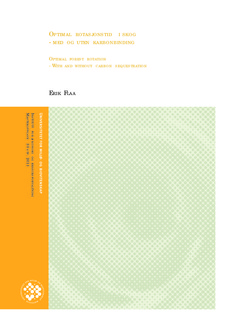| dc.description.abstract | Denne masteroppgaven sammenligner samfunnets optimale rotasjonstid for skogen med den private optimale rotasjonstiden for skogen. Dette blir i hovedsak gjort ved hjelp av enkle modeller. Skogen blir i dag avvirket når skogeier maksimerer sine inntekter, og det er som regel bare tømmerverdien som blir tatt hensyn til. Andre kollektive goder som ikke gir inntekt til skogeier blir ikke vektlagt. Som et resultat av dette kan produksjonen av kollektive goder i skogen bli for liten, og samfunnets optimale rotasjonstid er derfor nødvendigvis ikke lik den private optimale rotasjonstiden.
Et av skogens kollektive goder er at den tar opp karbon gjennom fotosyntesen, og i oppgaven er dette det eneste kollektive godet som er formelt analysert i modeller. Ved hjelp av enkle modeller tar oppgaven altså for seg den private optimale rotasjonstiden, som bare maksimerer tømmerinntekter, og samfunnets optimale rotasjonstid, som bare maksimerer tømmer og karbonverdier, og sammenligner disse. Da flere prognoser spår en økning i prisen på karbon fremover, tar oppgaven også for seg hvordan en endring i karbonprisen over tid spiller inn på den optimale rotasjonstiden. Oppgavens problemstillinger er derfor:
1.Hva er forskjellen mellom den private optimale rotasjonstiden og samfunnets optimale rotasjonstid?
2.Hvordan blir samfunnets optimale rotasjonstid påvirket av en endring i karbonprisen?
Oppgaven viser at samfunnets optimale rotasjonstid er lenger enn den private optimale rotasjonstiden ved konstante karbonpriser. Ved endrede karbonpriser over tid, vil effekten på samfunnets optimale rotasjonstid avhenge av endringen på prisen, diskonteringsrenta og skogens funksjon av tømmervolum over tid. Virkningene på rotasjonstidene ved ulike scenarioer er også illustrert grafisk. Her er det viktig å merke seg at disse kun er illustrative, og ikke kan brukes til å finne den eksakte optimale rotasjonstiden.
For å holde modellene enkle og intuitive, inneholder de en rekke forenklinger og forutsetninger. Disse vil spille inn på resultatet av de optimale rotasjonstidene, og er derfor viktige å være klar over. Modellene gir for eksempel bare den optimale rotasjonstiden gitt at skogen blir avvirket. Selv om en modellen gir en optimal rotasjonstid, kan det derfor likevel hende at det lønner seg å ikke avvirke skogen.
Diskusjonsdelen tar for seg flere andre forutsetninger og forenklingers påvirkning på den optimale rotasjonstiden. I tillegg blir det sett på hvordan skogens andre goder, som for eksempel biologisk mangfold, rekreasjonstjenester og jakt, kan påvirke skogens optimale rotasjonstid.
This master thesis compares the private optimal rotation time for the forest with the social optimal rotation time for the forest. This is primarily done through simple models. Today the forest is harvested when the forest owner maximizes his or her revenue, and only the timber value is usually taken into account. Other public goods that do not provide revenues to the forest owner are not emphasized. As a result, production of the public goods of the forest will be too small, and the private optimal rotation time is thus not necessarily equal to the social optimal rotation period.
Carbon sequestration through the photosynthesis is one of the public goods from the forest. In this thesis this is the only public good that is formally treated in the models. Through simple models the thesis thus address the private optimal rotation time, which only maximizes the timber value, and the social optimal rotation time, which maximizes the timber value and the carbon sequestration, and compares the two. As several forecasts predict an increase in the price of carbon, the paper also addresses how changes in the carbon price over time affect the optimal rotation time. Thus, the research questions of the thesis are:
1. What is the difference between the private optimal rotation time and the social optimal rotation time?
2. How is the social optimal rotation time affected by a change in the price of carbon?
The thesis shows that the social optimal rotation time is longer than the private optimal rotation time at constant carbon prices. How changes in the price of carbon over time affect the social optimal rotation time, depends on the change in the carbon price, the discount rate, and the forest’s function of timber volume over time. Graphs are included in the paper to illustrate the optimal rotation times at different scenarios, but it is important to note that these are only meant to be illustrative, and can not be used to find the exact optimal rotation time.
To keep models simple and intuitive, they include a number of simplifications and assumptions. These will affect the results of the optimal rotation times, and are therefore important to be aware of. The models for example only give the optimal rotation time given that the forest is harvested. So even if a model gives an optimal rotation time, it might still be profitable not to harvest the forest.
The discussion chapter deals with several other assumptions’ and simplifications’ effect on the optimal rotation time. In addition, it examines how other benefits from the forest, such as biodiversity, recreational services and hunting might effect the optimal rotation time. | no_NO |
